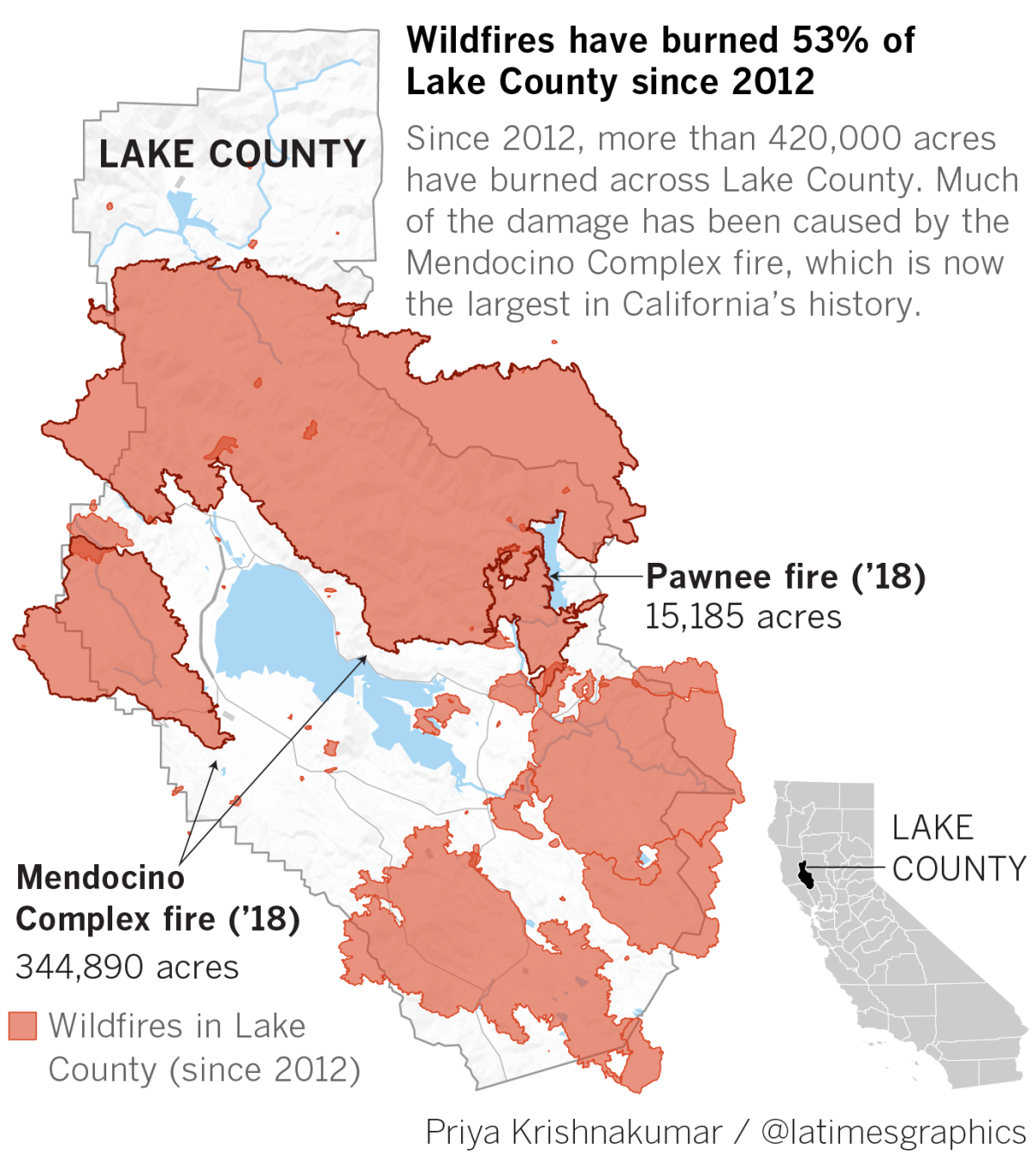More than 50% of this California county has burned since 2012. Some residents say they’ve had enough
- Share via
Reporting from MIDDLETOWN, Calif. — Clarence Sibsey sat alone at a table in the Twin Pine Casino evacuation center, tired and dejected.
Once again, a fire was threatening his community and he had to leave home. Two years ago, he fled the massive Valley fire. Now he had been driven away by the Mendocino Complex fire, which at more than 340,000 acres is the biggest in California history.
“We’ve never had fires like this before,” Sibsey said. “Why now?”
The battle to control the massive blaze continued Monday, as officials announced the death of a Utah firefighter on the front lines. The unidentified firefighter was airlifted to a hospital, where he died. Authorities said “fact-finding on the accident” was underway.
The news came amid progress in containing the fire, which enabled more residents to return home.
But the blaze has been a grim reminder for Lake County residents of how their area is now an epicenter for fires.
A Los Angeles Times analysis found that more than 50% of the county’s land has been burned since 2012. And it has sparked debate for some residents about whether living in this rural enclave about 120 miles north of San Francisco is worth it.
The Pawnee fire recently threatened nearby Spring Valley, whose residents had to evacuate for a second time in just a few months.
Two years ago, the Clayton fire tore through almost 4,000 acres and 300 structures, many of them mobile homes and rentals. The blaze hit the town of Lower Lake particularly hard, destroying a 150-year-old church and a Habitat for Humanity office.
In 2015, three wildfires ripped through Lake County, including the Valley fire, which destroyed more than 1,300 homes and killed at least four people.
Resident Bo Stover said he won’t be around for the next big blaze. He’s tired of the displacement and dangers, and plans to move to Arkansas.

“I’m sick of all this. I’m too old. I’m looking for peace in my life,” the 61-year-old said as he sat in the evacuation center.
In the last five to 10 years, the Lake County region has become one of the most active in the state in terms of fires, said Lynne Tolmachoff, a spokeswoman for the California Department of Forestry and Fire Protection.
Twenty years ago, it was Southern California — in areas such as Orange and Riverside counties — that experienced the most fires, officials said. Now Lake County competes for the top spot, along with Mariposa County.
Lake County’s topography, specifically its canyons, mean winds travel quickly there, Tolmachoff said. But what has made the area more prone to fire recently is the growing popularity of Napa and Sonoma valleys’ wine country spilling into Lake County, she said. More people means more opportunities for fires to start.
UCLA climate scientist Daniel Swain said the Mendocino Complex fire — actually two blazes, the Ranch fire and the River fire — became so bad because of explosively flammable vegetation, warm overnight temperatures and the lingering effect of years of drought. The blaze has burned mostly into the Mendocino National Forest.
Full coverage of the California wildfires »
“It’s sort of this middle elevation, where you’re above the marine layer, but you’re not high enough in the mountains to really cool down either,” he said.
Lake County has about 64,000 residents, most of whom live in communities along the shore of Clear Lake. While considered part of wine country, it does not share the same upscale vibe as Napa and Sonoma counties to the south.
Rick Bennett, who lives in the community of Nice, said Lake County has seen some big fires over the years, but nothing compared to the Mendocino Complex. He wondered what the landscape will look like when the fire is finally contained.
“We’re losing so many of our natural resources,” he said. “People are afraid to come. I’d be a liar if I said there wasn’t a part of me that wants to leave.”
Longtime residents said it has proved difficult to deal with this new constant threat of fire.
“You think, ‘Oh, it’ll never happen to me,’” Bennett said, adding that he tends to forget about the fires until temperatures start to climb. That’s when he gets anxious.
“It’s getting to where I dread the summer. I don’t want to see summer come,” he said.
When the Mendocino Complex fire forced him to evacuate, Bennett took a small bag full of essentials. He’s had to use resources from the Red Cross, such as clothing and toiletries.
Rose Mary Santana, an Upper Lake resident who lost her mobile home to the Mendocino Complex fire, said she was shocked by how it had spread.
“I wasn’t expecting it. We’ve had so many threats, and they never made it” to Upper Lake, she said.
This time was different.
When it came time to evacuate, Santana was in the home of one of the senior citizens she cares for, packing up her client’s valuables. She had nothing on her, not even her purse.
But, she said, she was hesitant to give up living in Lake County, where she moved to escape the “rat race.”
“God would never put too much on my shoulders,” Santana said. “I have the will to keep going.”
But Shelly Clayton, who lives in Nice, said she is thinking of moving back to Torrance, her hometown, to avoid the danger.
She said the Lake County climate is beginning to feel like “one long fire.”
“It’s emotional watching your community lose their livelihood,” she said. “It’s just horrible. I’m sick and tired of it. It’s a beautiful area, but I’m done.”
Reyes-Velarde reported from Lake County and Krishnakumar from Los Angeles. Times staff writer Rong-Gong Lin II in San Francisco contributed to this report.
UPDATES:
7:50 a.m.: This story was updated with more details about the firefighter who died.
This story was originally published at 4 a.m.
More to Read
Sign up for Essential California
The most important California stories and recommendations in your inbox every morning.
You may occasionally receive promotional content from the Los Angeles Times.












